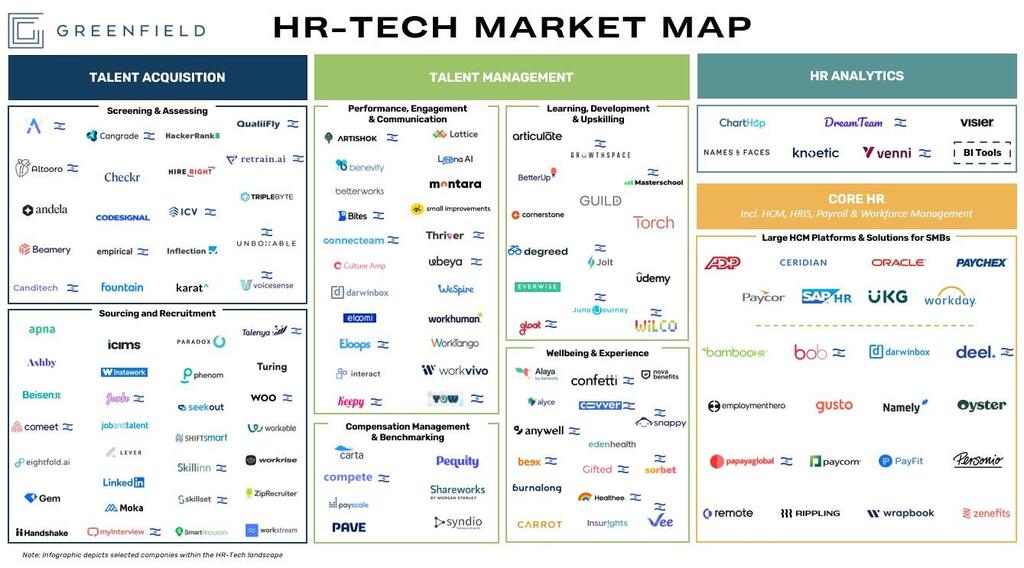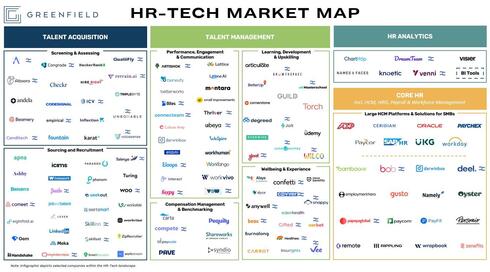
Analysis
Mapping the HR-Tech landscape
Talented, motivated employees have always served as the cornerstone of successful companies. In today’s era of increased competition over highly qualified talent, and new employment models like remote work - leveraging technology to stay ahead of the curve is more vital than ever
HR has always comprised a core focus area for companies small and large. Thanks to technological innovation and significant investments in the space, new tools and solutions have given rise to a new category; HR-Tech, a sector that has been garnering headlines in recent years.
HR-Tech provides solutions across the entire employee lifecycle, from recruitment and hiring, training, development, to ultimately retirement. This disruption to traditional HR is fueled by both management teams viewing HR not as cost centers, but as competitive advantages, as well as enabling technologies such as AI/ML and analytics driving the field forward.
The HR technology space has changed dramatically over the past few decades. Tracing its inception to System of Record platforms focused on automating paper transactions and record-keeping, the HR-Tech stack has since expanded to include a variety of platforms such as Applicant Tracking Systems (ATS), Workforce Planning (ERP systems), Systems of Engagement (HCM systems), Talent Management, and Employee Experience tools. Most recently, leading companies have ventured into what has been called Talent Science- tools designed to leverage analytics that assess employee behavior and performance.
Given the ongoing market turbulence, hiring, developing, and talent retention remain a priority for global enterprises with increasing focus from C-level personnel on deploying resources, experimenting, and adopting HR-empowering technologies as a crucial element to their operations. Even so, in the current environment, we see increased focus across the enterprise software stack on solutions that more directly reduce costs or increase revenue, with HR being no exception.
Partly driven by the pandemic, investment in HR-Tech reached an all-time high totaling $12.5 billion in 2021 and accelerated to $7.5 billion in the first half of 2022 alone, demonstrating strong investor appetite. Prior to Covid-19, the sector produced only 10 unicorns dating back to pioneering HR SaaS platform Workday (now worth around $40 billion), while increased interest from investors led to 15 new unicorns in 2021 alone. Today, the space’s largest incumbents (namely Oracle, Workday, SAP, ADP) compete with hundreds of agile and innovative players in nearly every market segment.
As investors, we view the constant struggle our portfolio companies face with regards to HR. Thus, it comes as no surprise that in the same spirit these companies are innovating on the product front, they are also innovating in the way they think about their employee base. This, coupled with significant advances in cloud, big data, and AI/ML are enabling the rise of new technology, which is in turn driving several key trends within HR:
1. Emphasizing skills vs. experience – Recent hiring trends have proven conventional CVs are no longer the ‘one source of truth’ for ensuring ideal employee-company fit. The talent acquisition processes are undergoing a revolution; novel technologies introduced by Skillset, Unboxable, Retrain.ai, Canditech and MyInterview dramatically optimize time and effort spent on qualifying proper candidates, enabling enterprises to improve their talent sourcing abilities while streamlining the overall hiring process.
2. Leveraging data and analytics for HR – Consistent across many different industries, organizations are increasingly shifting towards data-driven decision-making, with HR being no exception. Cohorts of new entrants such as HiredScore, DreamTeam, and Compete are building tools to decipher insights into massive data troves to boost growth, swapping decisions based on intuition to ones backed by concrete data.
3. Prioritizing Diversity, Equity and Inclusion (DEI) – Covid-19, alongside the Great Resignation and social movements such as #MeToo, have been a driving force for DEI, in turn fostering stronger organizational culture. Solutions developed by Israeli startups such as Joonko are enabling organizations to better execute on these key imperatives.
Related articles:
4. Global Recruitment and International Team Management – Growing remote workforces and shortage of qualified talent has spurred enterprises to expand their teams to decentralized, globalized pools of talent. Startups and marketplaces such as A.Team break down borders in locating talented individuals and teams for project building, while others such as Papaya and Deel are powerful tools for global workforce management and compliance with varying local regulations.
5. Focus on employee experience (EX) and development – Employees want more from their job – today, work satisfaction and career development are as important to them as salary and job title. A plethora of innovation by companies such as Gloat, GrowthSpace, Centrical, Bites, is focusing on employee development, wellness, and growth in order to retain talent.
6. Investing in employee wellbeing and benefits – To foster a sense of belonging and culture in the rising hybrid work model while preventing “burn-outs,” employee mental health, personal time, and wellbeing are becoming increasingly important topics. Companies such as Covver, Sorbet, and Beex equip HR teams with the resources necessary to care for the modern workforce.
Ortal Sasson is an Investment Associate at Greenfield Partners.

